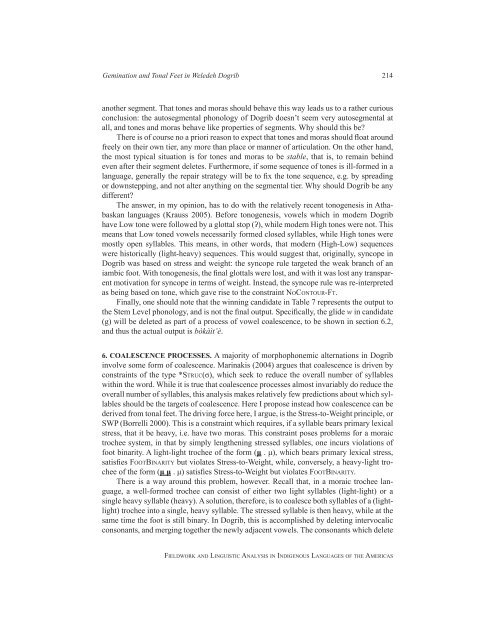Fieldwork and Linguistic Analysis in Indigenous ... - ScholarSpace
Fieldwork and Linguistic Analysis in Indigenous ... - ScholarSpace
Fieldwork and Linguistic Analysis in Indigenous ... - ScholarSpace
Create successful ePaper yourself
Turn your PDF publications into a flip-book with our unique Google optimized e-Paper software.
Gem<strong>in</strong>ation <strong>and</strong> Tonal Feet <strong>in</strong> Weledeh Dogrib 214<br />
another segment. That tones <strong>and</strong> moras should behave this way leads us to a rather curious<br />
conclusion: the autosegmental phonology of Dogrib doesn’t seem very autosegmental at<br />
all, <strong>and</strong> tones <strong>and</strong> moras behave like properties of segments. Why should this be?<br />
There is of course no a priori reason to expect that tones <strong>and</strong> moras should float around<br />
freely on their own tier, any more than place or manner of articulation. On the other h<strong>and</strong>,<br />
the most typical situation is for tones <strong>and</strong> moras to be stable, that is, to rema<strong>in</strong> beh<strong>in</strong>d<br />
even after their segment deletes. Furthermore, if some sequence of tones is ill-formed <strong>in</strong> a<br />
language, generally the repair strategy will be to fix the tone sequence, e.g. by spread<strong>in</strong>g<br />
or downstepp<strong>in</strong>g, <strong>and</strong> not alter anyth<strong>in</strong>g on the segmental tier. Why should Dogrib be any<br />
different?<br />
The answer, <strong>in</strong> my op<strong>in</strong>ion, has to do with the relatively recent tonogenesis <strong>in</strong> Athabaskan<br />
languages (Krauss 2005). Before tonogenesis, vowels which <strong>in</strong> modern Dogrib<br />
have Low tone were followed by a glottal stop (ʔ), while modern High tones were not. This<br />
means that Low toned vowels necessarily formed closed syllables, while High tones were<br />
mostly open syllables. This means, <strong>in</strong> other words, that modern (High-Low) sequences<br />
were historically (light-heavy) sequences. This would suggest that, orig<strong>in</strong>ally, syncope <strong>in</strong><br />
Dogrib was based on stress <strong>and</strong> weight: the syncope rule targeted the weak branch of an<br />
iambic foot. With tonogenesis, the f<strong>in</strong>al glottals were lost, <strong>and</strong> with it was lost any transparent<br />
motivation for syncope <strong>in</strong> terms of weight. Instead, the syncope rule was re-<strong>in</strong>terpreted<br />
as be<strong>in</strong>g based on tone, which gave rise to the constra<strong>in</strong>t nocontour-ft.<br />
F<strong>in</strong>ally, one should note that the w<strong>in</strong>n<strong>in</strong>g c<strong>and</strong>idate <strong>in</strong> Table 7 represents the output to<br />
the Stem Level phonology, <strong>and</strong> is not the f<strong>in</strong>al output. Specifically, the glide w <strong>in</strong> c<strong>and</strong>idate<br />
(g) will be deleted as part of a process of vowel coalescence, to be shown <strong>in</strong> section 6.2,<br />
<strong>and</strong> thus the actual output is bòkàìt’è.<br />
6. COALESCENCE PROCESSES. A majority of morphophonemic alternations <strong>in</strong> Dogrib<br />
<strong>in</strong>volve some form of coalescence. Mar<strong>in</strong>akis (2004) argues that coalescence is driven by<br />
constra<strong>in</strong>ts of the type *struc(σ), which seek to reduce the overall number of syllables<br />
with<strong>in</strong> the word. While it is true that coalescence processes almost <strong>in</strong>variably do reduce the<br />
overall number of syllables, this analysis makes relatively few predictions about which syllables<br />
should be the targets of coalescence. Here I propose <strong>in</strong>stead how coalescence can be<br />
derived from tonal feet. The driv<strong>in</strong>g force here, I argue, is the Stress-to-Weight pr<strong>in</strong>ciple, or<br />
SWP (Borrelli 2000). This is a constra<strong>in</strong>t which requires, if a syllable bears primary lexical<br />
stress, that it be heavy, i.e. have two moras. This constra<strong>in</strong>t poses problems for a moraic<br />
trochee system, <strong>in</strong> that by simply lengthen<strong>in</strong>g stressed syllables, one <strong>in</strong>curs violations of<br />
foot b<strong>in</strong>arity. A light-light trochee of the form (μ . μ), which bears primary lexical stress,<br />
satisfies footb<strong>in</strong>arity but violates Stress-to-Weight, while, conversely, a heavy-light trochee<br />
of the form (μ μ . μ) satisfies Stress-to-Weight but violates footb<strong>in</strong>arity.<br />
There is a way around this problem, however. Recall that, <strong>in</strong> a moraic trochee language,<br />
a well-formed trochee can consist of either two light syllables (light-light) or a<br />
s<strong>in</strong>gle heavy syllable (heavy). A solution, therefore, is to coalesce both syllables of a (lightlight)<br />
trochee <strong>in</strong>to a s<strong>in</strong>gle, heavy syllable. The stressed syllable is then heavy, while at the<br />
same time the foot is still b<strong>in</strong>ary. In Dogrib, this is accomplished by delet<strong>in</strong>g <strong>in</strong>tervocalic<br />
consonants, <strong>and</strong> merg<strong>in</strong>g together the newly adjacent vowels. The consonants which delete<br />
fieldwork <strong>and</strong> l<strong>in</strong>guistic analysis <strong>in</strong> <strong>in</strong>digenous languages of the americas

















